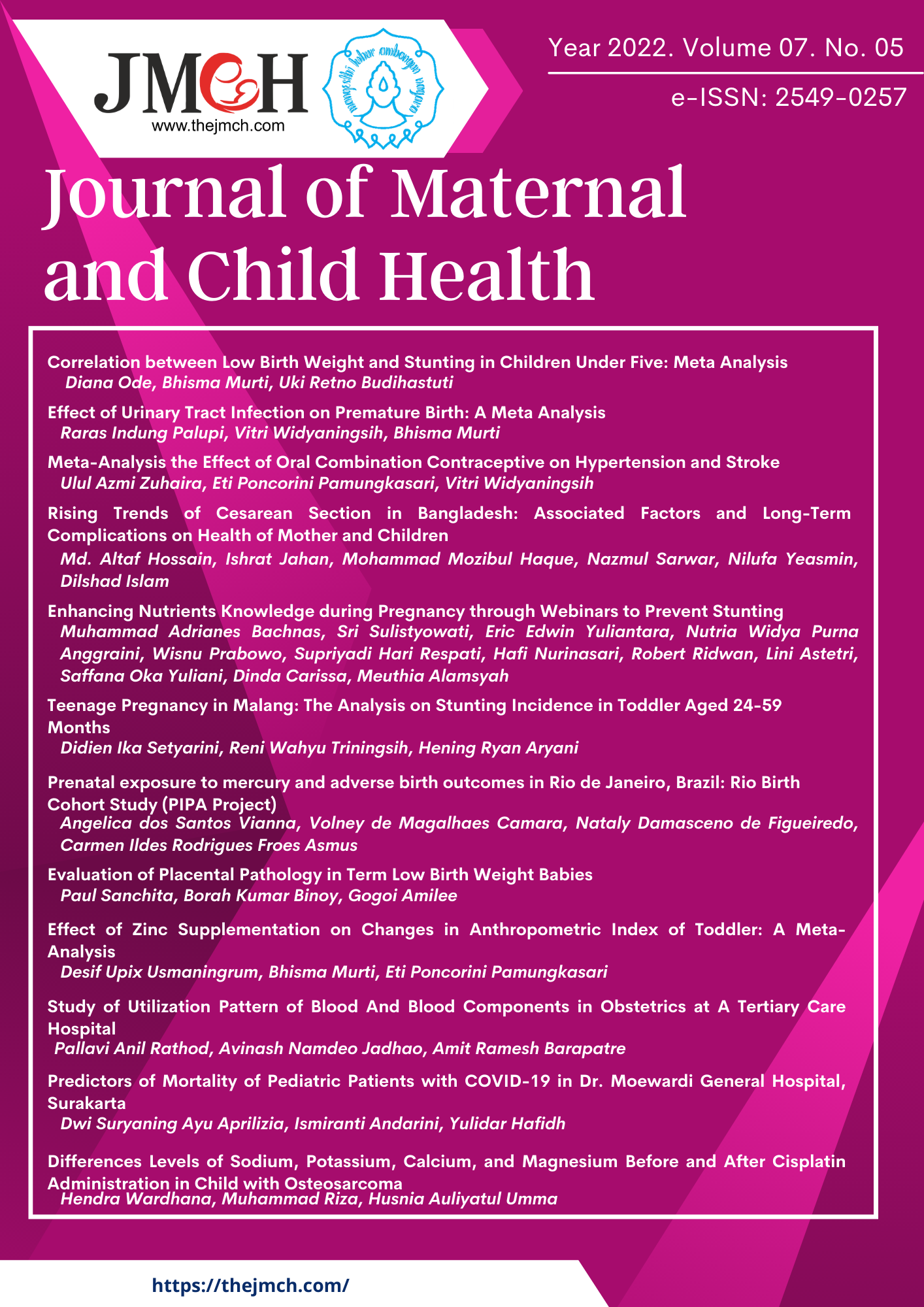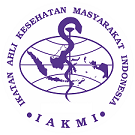Correlation between Low Birth Weigth and Stunting in Children Under Five: Meta Analysis
DOI:
https://doi.org/10.26911/thejmch.2022.07.05.01Abstract
Background: Stunting in children is a risk factor for increasing child mortality. The purpose of this study was to determine the relationship between LBW and the incidence of stunting based on previous primary studies.
Subjects and Method: This research was conducted using a meta-analysis study with PICO as follows: P = toddler, I = low birth weight, C = normal birth weight, O = stunting. Search articles in this study using 3 databases, namely Pubmed, Google Scholar and Springerlink. Search articles using the following keywords: Low birth weight AND Stunted OR Birth weight AND Stunted, articles were analyzed using the Review Manager 5.3 application.
Results: There are 11 articles from Rwanda, Nepal, Ethiopia, Eastern Kenya, Pakistan, China, Indonesia, and Tanzania from 2017-2022 which were analyzed using PRISMA flow diagrams. The results of this study indicate that toddlers who have a history of being born with low birth weight have a risk of experiencing stunting as much as 2.19 times compared to toddlers who have a history of birth with normal birth weight (aOR= 2.19; 95% CI= 1.77 to 2.69; p<0.001).
Conclusion: Toddlers with a history of LBW births are at risk for stunting.
Keywords: LBW, stunting, toddlers, meta-analysis.
Correspondence: Diana Ode. Master’s Program in Public Health, Universitas Sebelas Maret. Jl.Lawu raya Seturan Caturtunggal Depok Sleman Yogyakarta 55281 Indonesia. Email: dianaodef161@gmail.com. Mobile: +6285395912173.
References
Abeway S, Gebremichael B, Murugan R, Assefa M, Adinew YM (2018). Stunting and its determinants among children aged 6-59 months in northern Ethiopia: a cross-sectional study. J Nutr Metab. 2018:1078480. doi: 10.1155/2018/1078480.
Adhikari RP, Shrestha ML, Acharya A, Upadhaya N (2019). Determinants of stunting among children aged 0-59 months in Nepal: findings from Nepal Demographic and health Survey, 2006, 2011, and 2016. BMC Nutr. 5(1): 1–10. doi: 10.1186/s4079501903000.
Ahishakiye A, Abimana MC, Beck K, Miller AC, Betancourt TS, Magge H, et al. (2019). Developmental outcomes of preterm and low birth weight toddlers and term peers in Rwanda. Ann Glob Health, 85(1): 1–11. doi: 10.5334/aogh.2629.
Badriyah L, Syafiq A (2013). The association between sanitation, hygiene, and stunting in children under two-years (an analysis of indonesia’s basic health research, 2013). Makara J. Health. Res. 21(2). doi: 10.7454/msk.v21i2.6002.
Dake SK, Solomon FB, Bobo TM, Tekle HA, Tufa EG (2019). Predictors of stunting among children 6– 59 months of age in Sodo Zuria District, South Ethiopia: a community based cross-sectional study. BMC Nutr, 5(23): 1–7. doi: 10.1186/s4079501902876.
Farah AM, Nour TY, Endris BS, Gebreyesus HS (2021). Concurrence of stunting and overweight/ obesity among children: Evidence from Ethiopia, PLoS One, 16(1): 1–17. doi:1 0.1371/journal.pone.0245456.
Gonete AT, Kassahun B, Mekonnen EG, Takele WW (2021) Stunting at birth and associated factors among new-borns delivered at the University of Gondar Comprehensive Specialized Referral Hospital, PLoS One, 16(1): 1–16.doi:10.1371/journal.pone.0245528.
Guruge NG, Goonasekara M, Dharmaratne S, Gunathunga M (2017). Engaging a rural community in identifying determinants of low birth weight and deciding on measures to improve low birth weight: an experience from a Sri Lankan Study. J Health Popul Nutr. 36(1): 36-41. doi:10.1186/s4104301701189.
Guyatt H, Muiruri F, Mburu P, Robins A (2020). Prevalence and predictors of underweight and stunting among children under 2 years of age in Eastern Kenya. Public Health Nutr. 23(9): 1599–1608, 2020. doi: 10.1017/S1368980019003793.
Ibrahim I, Alam S, Adha AS, Jayadi YI, Fadlan M (2021). Hubungan sosial budaya dengan kejadian stunting pada balita usia 24-59 bulan di Desa Bone-Bone Kecamatan Baraka Kabupaten Enrekang Tahun 2020 (Socio-cultural relationship with the inci-dence of stunting in toddlers aged 24-59 months in Bone-Bone Village, Baraka District, Enrekang Regency in 2020), Public Health Nutr J. 1(1):16–26.
Khan S, Zaheer S, Safdar F (2019) Determinants of stunting, underweight and wasting among children < 5 years of age: evidence from 2012-2013 Pakistan demographic and health survey, BMC Public Health, 19(1): 358. doi: 10.1186/s1288901966882.
Li H, Yuan S, Fang H, Huang G, Huang Q, Wang H, Wang A (2022) Prevalence and associated factors for stunting, underweight and wasting among children under 6 years of age in rural Hunan Province, China: a community-based cross-sectional study. BMC Public Health, 22(1): 483. doi: 10.11-86/s1288902212875w.
Lukman TNE, Anwar F, Riyadi H, Harjo-midjojo H, Martianto D (2021). Birth weight and length associated with stunting among children under-five in Indonesia. I Jurnal Gizi Dan Pangan, 16(1): 99–108.
Makori N, Kassim N, Kinabo J, Matemu A (2018). Factors associated with stun-ting in Dodoma Region, Tanzania, African J. Food, Agric. Nutr. Dev, 18 (3): 13842–13861. doi: 10.18697/AJFAND.83.17000.
Mtongwa RH, Festo C (2021). A compara-tive analysis of determinants of low birth weight and stunting among under five children of adolescent and nonadolescent mothers using 2015/16 Tanzania Demographic and Health Survey (TDHS), BMC Nutr, 7(1). doi: 10.1186/s40795-021-00468-6.
Murti B (2018). Prinsip dan metode riset epidemiologi (Epidemiological resear-ch principles and methods). 5th edn. Surakarta: Program Studi Ilmu Kese-hatan Masyarakat, Program Pasca-sarjana, Universitas Sebelas Maret.
Nainggolan BG, Sitompul M (2019). Hubungan berat badan lahir rendah (bblr) dengan kejadian stunting pada anak usia 1-3 tahun (The relationship between low birth weight (bblr) and the incidence of stunting in children aged 1-3 years), Nutr. J, 3(1): 36. doi: 10.37771/nj.vol3.iss1.390.
Novianti I, Mardianti D, Muchtar AS (2020). Pemberian asi dan BBLR berhubungan dengan kejadian stunting pada balita usia 12-36 bulan (Breast-feeding and LBW are associated with the incidence of stunting in toddlers aged 12-36 months), J. Kebidanan Malahayati, 6(3): 329–334. doi: 10.33024/jkm.v6i3.2701.
PERMENKES RI (2020). Peraturan menteri kesehatan Republik Indonesia nomor 2 tahun 2020 tentang standar antropometri anak (Peraturan menteri kesehatan Republik Indonesia nomor 2 tahun 2020 tentang standar antropometri anak).
Santosa A, Novanda E, Ghoni DA (2022). Effect of maternal and child factors on stunting: partial least squares structural equation modeling. Clin. Exp. Pediatr, 65(2): 90-97. doi: 10.3345/cep.2021.00094.
Sartika AN, Khoirunnisa M, Meiyetriani E, Ermayani E, Pramesthi IL, Ananda AJN (2021) Prenatal and postnatal determinants of stunting at age 0–11 months: A cross-sectional study in Indonesia, PLoS One. 16(7): e0254662. doi: 10.1371/journal.pone.0254662.
Sukmawati, Hendrayati, Chaerunnimah, Nurhumaira (2018). Status gizi ibu saat hamil, berat badan lahir bayi dengan stunting pada balita (Maternal nutritional status during pregnancy, birth weight of babies with stunting in toddlers). Media Gizi Pangan, 25(1): 18–24. doi: 10.32382/mgp.v25i1.55.










